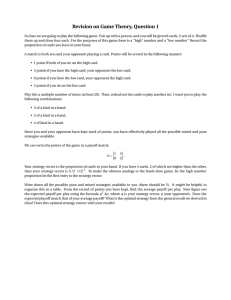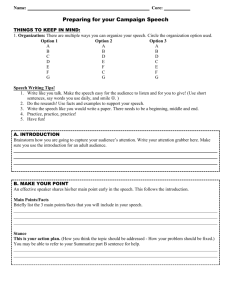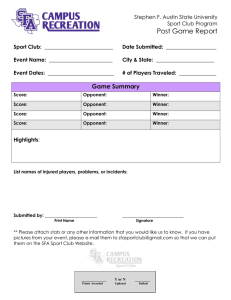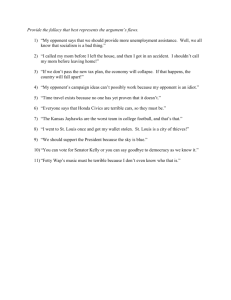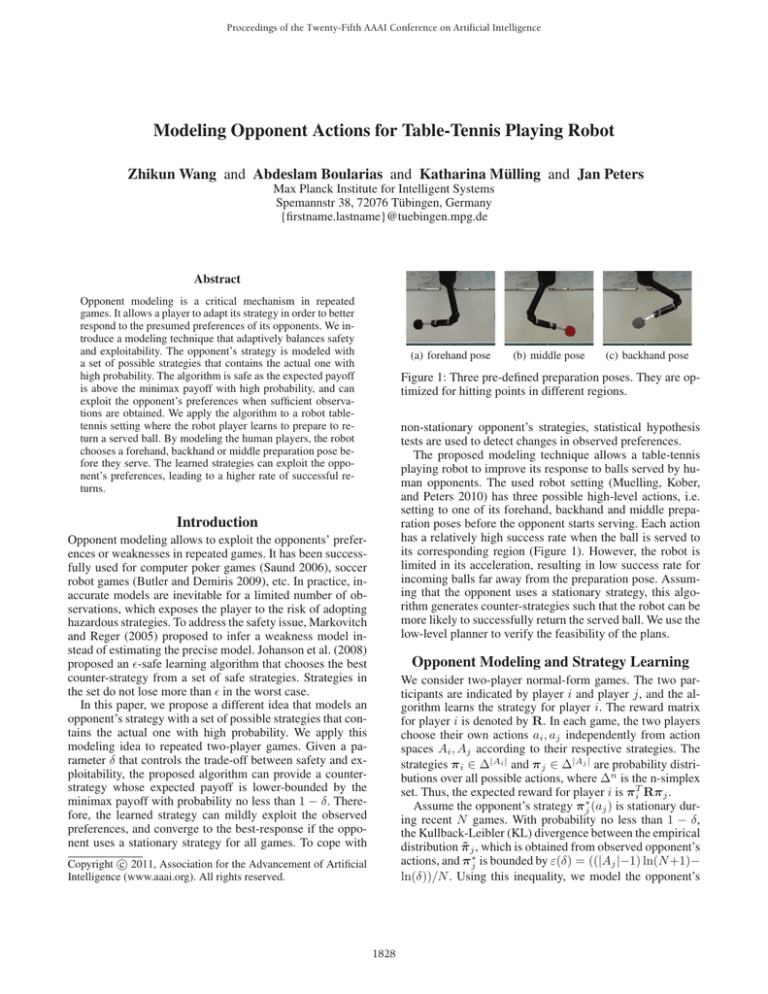
Proceedings of the Twenty-Fifth AAAI Conference on Artificial Intelligence
Modeling Opponent Actions for Table-Tennis Playing Robot
Zhikun Wang and Abdeslam Boularias and Katharina Mülling and Jan Peters
Max Planck Institute for Intelligent Systems
Spemannstr 38, 72076 Tübingen, Germany
{firstname.lastname}@tuebingen.mpg.de
Abstract
Opponent modeling is a critical mechanism in repeated
games. It allows a player to adapt its strategy in order to better
respond to the presumed preferences of its opponents. We introduce a modeling technique that adaptively balances safety
and exploitability. The opponent’s strategy is modeled with
a set of possible strategies that contains the actual one with
high probability. The algorithm is safe as the expected payoff
is above the minimax payoff with high probability, and can
exploit the opponent’s preferences when sufficient observations are obtained. We apply the algorithm to a robot tabletennis setting where the robot player learns to prepare to return a served ball. By modeling the human players, the robot
chooses a forehand, backhand or middle preparation pose before they serve. The learned strategies can exploit the opponent’s preferences, leading to a higher rate of successful returns.
(a) forehand pose
(b) middle pose
(c) backhand pose
Figure 1: Three pre-defined preparation poses. They are optimized for hitting points in different regions.
non-stationary opponent’s strategies, statistical hypothesis
tests are used to detect changes in observed preferences.
The proposed modeling technique allows a table-tennis
playing robot to improve its response to balls served by human opponents. The used robot setting (Muelling, Kober,
and Peters 2010) has three possible high-level actions, i.e.
setting to one of its forehand, backhand and middle preparation poses before the opponent starts serving. Each action
has a relatively high success rate when the ball is served to
its corresponding region (Figure 1). However, the robot is
limited in its acceleration, resulting in low success rate for
incoming balls far away from the preparation pose. Assuming that the opponent uses a stationary strategy, this algorithm generates counter-strategies such that the robot can be
more likely to successfully return the served ball. We use the
low-level planner to verify the feasibility of the plans.
Introduction
Opponent modeling allows to exploit the opponents’ preferences or weaknesses in repeated games. It has been successfully used for computer poker games (Saund 2006), soccer
robot games (Butler and Demiris 2009), etc. In practice, inaccurate models are inevitable for a limited number of observations, which exposes the player to the risk of adopting
hazardous strategies. To address the safety issue, Markovitch
and Reger (2005) proposed to infer a weakness model instead of estimating the precise model. Johanson et al. (2008)
proposed an -safe learning algorithm that chooses the best
counter-strategy from a set of safe strategies. Strategies in
the set do not lose more than in the worst case.
In this paper, we propose a different idea that models an
opponent’s strategy with a set of possible strategies that contains the actual one with high probability. We apply this
modeling idea to repeated two-player games. Given a parameter δ that controls the trade-off between safety and exploitability, the proposed algorithm can provide a counterstrategy whose expected payoff is lower-bounded by the
minimax payoff with probability no less than 1 − δ. Therefore, the learned strategy can mildly exploit the observed
preferences, and converge to the best-response if the opponent uses a stationary strategy for all games. To cope with
Opponent Modeling and Strategy Learning
We consider two-player normal-form games. The two participants are indicated by player i and player j, and the algorithm learns the strategy for player i. The reward matrix
for player i is denoted by R. In each game, the two players
choose their own actions ai , aj independently from action
spaces Ai , Aj according to their respective strategies. The
strategies π i ∈ Δ|Ai | and π j ∈ Δ|Aj | are probability distributions over all possible actions, where Δn is the n-simplex
set. Thus, the expected reward for player i is π Ti Rπ j .
Assume the opponent’s strategy π ∗j (aj ) is stationary during recent N games. With probability no less than 1 − δ,
the Kullback-Leibler (KL) divergence between the empirical
distribution π̃ j , which is obtained from observed opponent’s
actions, and π ∗j is bounded by ε(δ) = ((|Aj |−1) ln(N +1)−
ln(δ))/N . Using this inequality, we model the opponent’s
c 2011, Association for the Advancement of Artificial
Copyright Intelligence (www.aaai.org). All rights reserved.
1828
Average expected reward
Average expected reward
Average expected reward
0.45
0.5
0.4
0.35
0.4
0.25
0.3
AER of pure strategy 1
AER of pure strategy 3
AER of learned strategy
0.2
0.1
0
0
10
20
30
40
50
60
70
80
90
AER of pure strategy 1
AER of pure strategy 3
AER of learned strategy
0.1
0.05
100
(a) Opponent with an uniform strategy.
0.7
0.65
0.2
0.15
Number of games
0.8
0.75
0.3
0
0
20
40
60
80
100
120
140
160
Number of games
(b) Opponent with a strong preference.
0.6
pure strategy 1
pure strategy 3
learned strategy without change detection
learned strategy with change detection
0.55
180
0.5
0.45
0
20
40
60
80
100
120
140
160
Number of games
(c) Opponent with changed strategies.
Figure 2: The curves show the average expected reward, where the pure strategy 1 and 3 always choose the forehand and middle
pose. They are the optimal strategy respectively in (b) and (a). The learned strategies converge to them for stationary opponent’s
strategy, and can adapt to changes of the opponent’s strategy.
strategy by Ω(δ) = {π j ∈ Δ|Aj | |KL(π̃ j ||π j ) ≤ ε(δ)},
which contains the actual strategy with probability no less
than 1 − δ. However, the player has no additional information to choose the actual strategy among all possible strategies in this set. To ensure safety of the counter-strategy,
we aim for the maximal expected payoff in the worst case:
π ∗i = arg maxπi ∈Δ|Ai | minπj ∈Ω(δ) π Ti Rπ j . Finding the
counter-strategy can be solved efficiently using sub-gradient
methods.
When the model Ω contains the actual strategy π ∗j , the
expected payoff of the best-response strategy has a lowerbound above the minimax payoff. Therefore, the counterstrategy is safe with probability no less than 1 − δ. The
learned strategy will converge to the best-response counterstrategy if the opponent’s strategy converges. In this case, the
cumulative expected regret bound with respect
√ to the bestresponse strategy has a growth rate of O( T ln T ), where
T is the number of played games so far.
The learned strategy is δ-safe only if observed N actions
are selected from the same strategy. However, the opponent
may change its strategy during the games. Therefore, an
adaptive learning algorithm is required to deal with the strategy changes. The proposed algorithm maintains two sets of
samples: a set X that contains observed actions for learning
a counter-strategy, and a set Y that serves as a validation set.
We test the hypothesis that the probability of executing any
action aj is the same in the local strategies that generated X
and Y . Therefore, the changes in the strategy can be detected
with high probability.
nents if they tend to serve the ball to a specific region more
frequently.
We recruited three volunteers to repeatedly serve the ball,
and analyze the performance of the algorithms. We measure
the performance by the Average Expected Reward (AER),
which is the sum of its expected reward divided by the number of trials. The first volunteer served the balls with approximately a uniform distribution over the three regions.
Therefore, the pure strategy 3 that always chooses the middle preparation pose leads to the maximal AER. As shown
in Figure 2(a), the learned strategies preform slightly worse
than it in the beginning as the algorithm starts from the minimax strategy, yet quickly converge to the optimal payoff.
The second volunteer had a significant preference to serve to
the right region. As shown in Figure 2(b), the learned strategies move gradually towards the optimal counter-strategy.
The third volunteer started with the preference of serving the ball to the middle/right side, and then intentionally
switched to favoring the middle/left side. Pure strategy 1 and
3 are optimal before and after the switch. We compare the
adaptive algorithm to the version without change detection
in this case. As shown in Figure 2(c), both algorithms have
decreased performance right after the switch. As the hypothesis test failed, the adaptive algorithm successfully detected
the strategy switch and adapted to it. Therefore, it achieved
the best overall performance.
Future Work
We will extend this modeling idea to more complicated
games, e.g. stochastic games, and use it for other robotic
applications.
Robot Table-Tennis
We consider the problem of choosing the preparation pose
for a served ball as a repeated two-player game. The robot
has three possible actions, namely, choosing the forehand,
backhand or middle preparation poses before the opponent serves. In the meantime, the opponent can choose
to serve the ball to the right, left or middle region. We
have no knowledge whether the opponent is competitive
or cooperative as the opponent’s reward is not available.
Whereas, an empiriRight
Left
Middle
cal reward matrix for
Forehand
0.6506
0.0648
0.5222
Backhand
0.0449
0.3889
0.1222
the robot can be comMiddle
0.4103
0.5648
0.7444
puted as the success
rates in previous games. Therefore, we roughly know how
well a robot’s preparation pose can return balls in those three
regions. The minimax play will choose the middle preparation pose with probability around 0.8 and the forehand pose
with probability 0.2. However, it does not exploit the oppo-
References
Butler, S., and Demiris, Y. 2009. Predicting the movements
of robot teams using generative models. Distributed Auton.
Robotics Systems 8:533–542.
Johanson, M.; Zinkevich, M.; and Bowling, M. 2008. Computing robust counter-strategies. Advances in Neural Information Processing Systems 20:721–728.
Markovitch, S., and Reger, R. 2005. Learning and exploiting
relative weaknesses of opponent agents. Autonomous Agents
and Multi-Agent Systems 10(2):103–130.
Muelling, K.; Kober, J.; and Peters, J. 2010. A Biomimetic
Approach to Robot Table Tennis. In Proceedings of IROS.
Saund, E. 2006. Capturing The Information Conveyed By
Opponents’ Betting Behavior in Poker. In IEEE Symposium
on Computational Intelligence and Games.
1829



